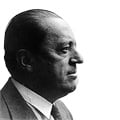
Despite the fact that the son of a mason from Aachen never received a professional degree, he seems to have been destined for the profession as an architect. He became familiar with construction through his father's business and at the age of 19, he moved to Berlin where he worked in the offices of Bruno Paul and Peter Behrens, two central figures of the reform movement.
Mies gained access to affluent, educated circles, including some collectors who drew his attention toward modern art. In the early 20s, he created the first designs for skyscrapers.
Now, after a failed marriage, he led the life of a bachelor who's modernist spirit renounced all "trivial decoration". However, even his revolutionary open floor plans - mostly for villas - never fully departed from the basic patterns for middle-class housing, including the separation of areas for men and women as well as partitions to the staff. Furniture was as byproduct of his buildings. His milestones include leading a project for the Stuttgart Weißenhofsiedlung (1927), his German Pavilion for the World Exposition in Barcelona (1929) as well as the Villa Tugendhat in the Moravian Brunn (1930). His global career began with refining the "cantilever chair", a concept by Mart Stam, presented in Stuttgart. He called the MR 9O chair for the world exhibition a "monumental object". The use of strip steel, which is relatively heavy, enabled the creation of a scissor shape and was unusual. Although the furniture was initially only produced at small scale, they influenced his style, such as the glass table with a visible cross frame and the chaise longue with its parallel bulges. Their importance can be seen not only the amount of plagiarism and the eventually successful remarketing, but also in the continuation of his ideas by major designers such as about Franco Albini and Poul Kjaerholm as well as the anti-designers of Archizoom. Although Mies van der Rohe is usually seen in conjunction with the Bauhaus movement, he had already developed his most important pieces before he became Bauhaus' last Director in 1930. His attempts to come to terms with the Nazi regime failed. At the end of the 30s, he emigrated to the United States, where he headed the Architectural Department of the Illinois Institute of Technology. Until his death, he was a popular architect around the world and was seen a grand master of the "International Style", next to Marcel Breuer and Walter Gropius.
Website by Ludwig Mies van der Rohe
 Knoll International
Knoll International
 Thonet
Thonet
 Vitra
Vitra